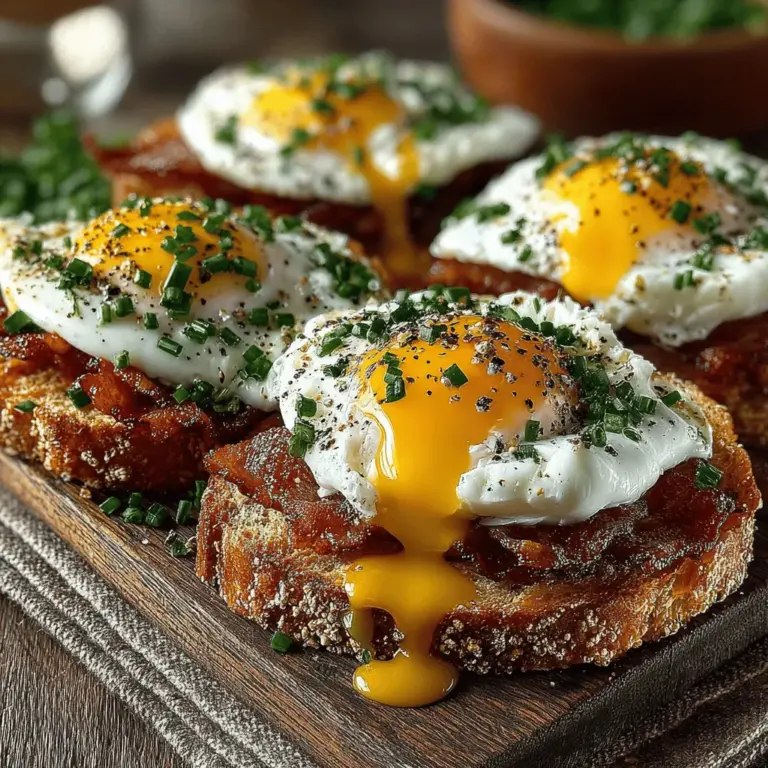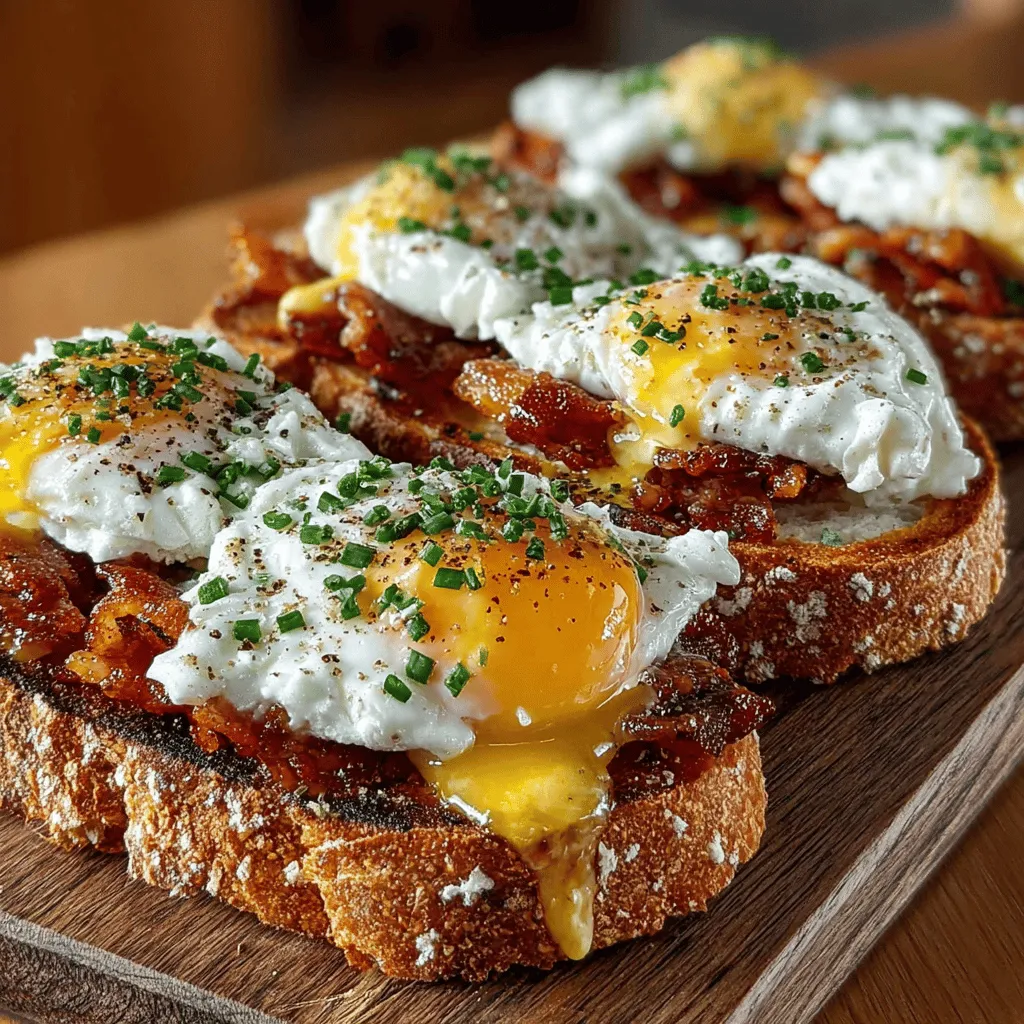Classic Eggs Benedict Recipe
Introduction
Eggs Benedict is a quintessential brunch dish that has captured the hearts and palates of food lovers around the world. This indulgent combination of poached eggs, savory Canadian bacon, and creamy hollandaise sauce served atop toasted English muffins makes for a luxurious breakfast experience. For home cooks, mastering the art of Eggs Benedict is not just about following a recipe; it’s a gateway to impressing guests and elevating weekend brunches into special occasions. The delightful interplay of flavors and textures—richness from the hollandaise, the tenderness of the poached eggs, and the crispiness of the muffins—creates a symphony that is hard to resist.
This article will take you through the journey of making Classic Eggs Benedict, exploring its history, essential ingredients, and the initial steps to achieving this culinary masterpiece. Whether you’re a seasoned chef or a kitchen novice, with a bit of patience and practice, you can create this iconic dish that is sure to impress.
Understanding Eggs Benedict
At its core, Eggs Benedict consists of several key components: a toasted English muffin, a slice of Canadian bacon or ham, a perfectly poached egg, and a rich hollandaise sauce. The beauty of this dish lies in its simplicity, yet it requires precision to master each element. The poached egg, with its runny yolk, adds a luxurious touch when broken, mingling with the creamy hollandaise and creating a delectable sauce that coats the muffin and bacon.
The origins of Eggs Benedict are somewhat murky, with several stories claiming its invention. One popular tale credits a Wall Street broker named Lemuel Benedict, who, in the late 19th century, ordered a unique breakfast at a New York City hotel. His order—a concoction of buttered toast, poached eggs, crispy bacon, and hollandaise sauce—was so well-received that it made its way onto the menu, evolving into the classic dish we know today. Over the years, Eggs Benedict has become a staple in brunch culture, often served in upscale restaurants and beloved by home cooks alike.
In addition to the traditional version, there are several delightful variations of Eggs Benedict that cater to different tastes and dietary preferences. For instance, Eggs Florentine swaps out the Canadian bacon for sautéed spinach, making it a perfect option for vegetarians. Eggs Royale features smoked salmon instead of bacon, adding a touch of elegance to the dish. Each variation retains the essence of Eggs Benedict while introducing unique flavors, ensuring there’s a version for everyone to enjoy.
Essential Ingredients for Classic Eggs Benedict
To create the perfect Classic Eggs Benedict, understanding the role of each ingredient is crucial. Here’s a breakdown of what you’ll need:
– Eggs: The star of the dish, fresh large eggs are essential for poaching. They should be as fresh as possible to ensure a firm white and a beautifully runny yolk. Fresh eggs hold their shape better when poached, resulting in a more visually appealing dish.
– English Muffins: While you can easily find store-bought English muffins, making your own can elevate the dish to new heights. Homemade muffins not only taste better but also allow for customization in texture and flavor.
– Canadian Bacon or Prosciutto: This ingredient adds a savory note to the dish. Canadian bacon is thicker and has a slightly smoky flavor, while prosciutto offers a delicate saltiness that pairs beautifully with the eggs. Choosing high-quality meat will enhance the overall taste.
– White Vinegar: A key component in the poaching process, white vinegar helps the egg whites coagulate quickly, resulting in a more compact and tender poached egg. It’s a small addition that can significantly improve the texture of your dish.
– Hollandaise Sauce Ingredients: The creamy hollandaise is what makes Eggs Benedict truly special. This sauce requires egg yolks, lemon juice, unsalted butter, cayenne pepper, and salt. The balance of acidity from the lemon juice and richness from the butter creates a luscious sauce that complements the other ingredients perfectly.
– Garnish: Fresh chives or parsley add not just a pop of color but also a subtle oniony flavor that enhances the dish’s presentation and taste. A sprinkle of finely chopped herbs can transform your Eggs Benedict from good to gourmet.
Step-by-Step Guide to Making Classic Eggs Benedict
Preparing the Hollandaise Sauce:
The first step in creating Classic Eggs Benedict is preparing the hollandaise sauce, which requires a bit of technique but is well worth the effort. For a smooth and creamy sauce, the double boiler method is recommended. Here’s how to do it:
1. Set Up Your Double Boiler: Fill a medium saucepan with a couple of inches of water and bring it to a simmer. Ensure that the bowl you use for the hollandaise sauce fits snugly on top of the saucepan without touching the water.
2. Combine Ingredients: In the heatproof bowl (preferably stainless steel), whisk together the egg yolks and lemon juice. Whisk vigorously until the mixture is pale and slightly thickened.
3. Heat Gently: Place the bowl over the simmering water, ensuring the bottom doesn’t touch the water. Continue whisking as the mixture heats up. This gentle heat will cook the yolks without scrambling them.
4. Incorporate the Butter: Gradually add the melted unsalted butter to the egg mixture, whisking continuously. The sauce should begin to thicken as you incorporate the butter. If it becomes too thick, you can add a teaspoon of warm water to loosen it.
5. Season and Serve: Once you achieve a smooth and creamy consistency, remove the bowl from heat. Season with salt and a pinch of cayenne pepper to taste. Keep the hollandaise sauce warm while you prepare the other components of the dish.
With the hollandaise sauce underway, you’re well on your way to creating a delightful Classic Eggs Benedict. The next steps will involve poaching the eggs and assembling your masterpiece, but first, mastering the sauce sets the foundation for this iconic brunch dish. Stay tuned for the continuation of this culinary journey!


